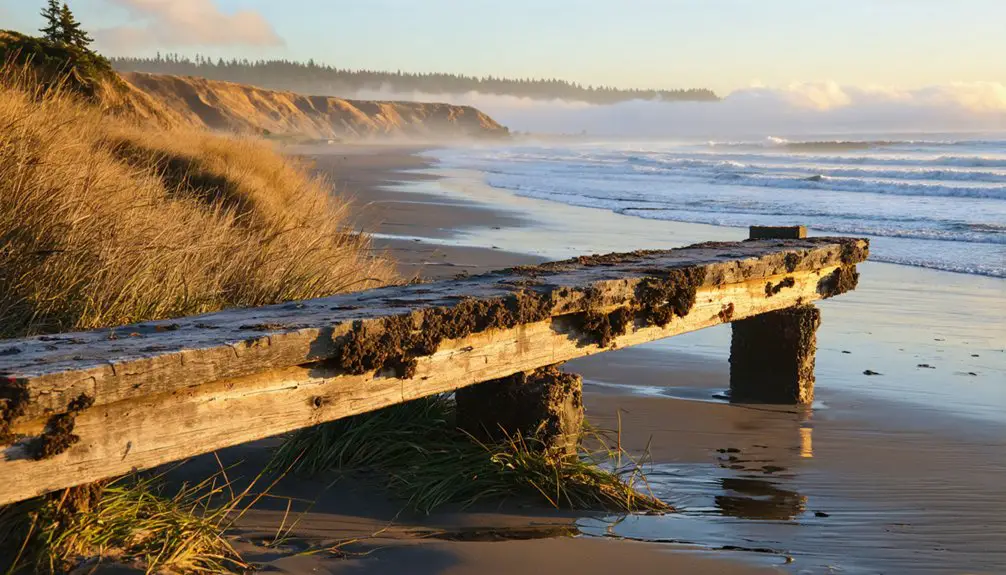You’ll find Bayocean’s ghostly remains on Oregon’s Tillamook Spit, where a grand seaside resort once stood between 1906 and the 1950s. Marketed as the “Atlantic City of the West,” this 600-acre paradise featured heated saltwater pools, a 1,000-seat theater, and luxury amenities for 2,000 residents. The fateful decision to build only a single jetty in 1932 triggered devastating erosion, and by 1960, the Pacific Ocean had reclaimed every last building. The tale of Bayocean’s demise holds sobering lessons about nature’s power.
Key Takeaways
- Bayocean was an ambitious coastal resort town in Oregon, marketed as the “Atlantic City of the West” before becoming abandoned.
- The town flourished between 1906-1914 with 2,000 residents, luxury amenities, and modern infrastructure including a heated natatorium.
- Poor engineering decisions, specifically building only one jetty, led to devastating coastal erosion that destroyed the community.
- By 1952, ocean erosion breached the peninsula, turning it into an island and forcing remaining residents to abandon their homes.
- Today, Bayocean is completely submerged, with no remaining structures, serving as a cautionary tale of coastal development failures.
The Birth of “Atlantic City of the West”
In 1906, real estate promoters Thomas Benton Potter and his son Thomas Irving Potter established Bayocean on Oregon’s Tillamook Spit, a narrow strip of land between Tillamook Bay and the Pacific Ocean.
You’ll find this ambitious coastal tourism venture was marketed as the “Atlantic City of the West,” aiming to create a luxurious seaside destination on 600 pristine acres. Francis Drake Mitchell built the first hotel and general store in 1907. The town quickly grew and reached a peak population of 2,000 residents by 1914.
A Luxurious Vision Takes Shape
As you walk the empty shores of Bayocean today, you’d never guess that in 1906, Thomas Benton Potter and his son Thomas Irving Potter launched their grand vision to transform this 4-mile sand spit into the “Queen of Oregon Resorts.”
Their ambitious plans materialized with the construction of a heated saltwater natatorium featuring a wave machine, a 1,000-seat movie theater, tennis courts, and golf links, while essential amenities like employee housing, a general store, and a Methodist church supported the growing community. Early visitors could only access this glamorous destination by boat access across Tillamook Bay.
You’d have found yourself amid what the Potters marketed as the “playground of millionaires,” complete with a bowling alley, dance pavilion, and bakery – all part of their dream to rival California’s prestigious Hotel Del Monte. A luxurious yacht transport service carried vacationers from Portland to Tillamook Bay, reducing the journey from two days to twelve hours.
Resort Dreams Take Flight
When Thomas Benton Potter and his son Thomas Irving Potter first gazed upon Oregon’s Tillamook Spit in 1906, they envisioned transforming the 600-acre peninsula into the “Atlantic City of the West.”
Their ambitious plan for Bayocean targeted wealthy vacationers with promises of luxurious amenities rarely seen on the Pacific Coast.
You’d find their coastal dreams taking shape through paved, illuminated streets and a private railroad for construction and joy rides.
Their resort aspirations materialized in a three-story hotel with modern fire sprinklers, a 160-foot heated saltwater pool with an electric wave machine, and entertainment venues including a 1000-seat theater and bowling alley.
To transport wealthy prospects, they launched the yacht *Bayocean*, the Pacific Coast’s largest vessel, ensuring exclusive access to this remote paradise until Bayocean Road’s completion in 1926.
Building Paradise From Sand
The ambitious transformation of Tillamook Spit into Bayocean began in 1906, starting with nothing but 600 acres of sandy peninsula between the Pacific Ocean and Tillamook Bay.
Despite sandy challenges, visionary founders Thomas Benton Potter and his son Thomas Irving created a luxurious resort from scratch, without road access from Portland.
Here’s what they accomplished:
- Built four miles of paved, lighted streets and essential infrastructure, including a diesel power plant, water system, and telephone lines.
- Constructed a heated natatorium with a wave machine, plus entertainment venues like bowling alleys and a 1,000-seat theater.
- Established transportation solutions with their own railroad system and the Pacific Coast’s largest yacht to ferry visitors from Portland.
Every amenity was carefully planned to create an elite destination worthy of being called the “Atlantic City of the West.”
Amenities Beyond Their Time
Building a paradise required more than just infrastructure – it demanded world-class amenities that would rival East Coast destinations.
You’d find luxury amenities everywhere: a heated 160-foot saltwater pool with an electric wave machine opened in 1914, a three-story hotel with automatic fire sprinklers, and paved streets illuminated for evening strolls. A custom private railroad line transported visitors directly to the resort town.
The recreational facilities would impress even the most discerning visitor. You could perfect your serve on certified tennis courts, practice your aim at the trapshooting range, or enjoy a round of golf.
For entertainment, you’d catch the latest films at the 1,000-seat theater, dance the night away at the pavilion, or try your luck at the amusement arcade.
The Bayocean yacht would whisk you there from Portland, showcasing the town’s commitment to sophisticated travel.
Life in Paradise: 1907-1914
By 1914, you’d find yourself amidst Bayocean’s state-of-the-art amenities, including paved streets illuminated by electric lights and a sophisticated telephone system powered by the town’s own diesel plant.
You could enjoy the 160-foot heated saltwater natatorium complete with an electric wave machine, or spend your evenings at the dance hall listening to orchestral music.
The resort’s luxurious facilities attracted wealthy tourists from across the Pacific Northwest, who’d arrive via the private railroad line or the passenger vessel “Bayocean” direct from Portland.
The development’s rapid growth was evident as a thousand lots sold within the first three months after sales began in 1907.
Early Luxuries and Amenities
During its early golden years from 1907 to 1914, Bayocean evolved into a luxurious coastal paradise that you’d expect to find in more established East Coast resorts.
The town’s recreational facilities rivaled the nation’s finest, featuring a heated saltwater natatorium with an innovative wave machine and a grand indoor pavilion for entertainment. Sadly, the natatorium’s excessive maintenance costs eventually forced its closure in 1927.
You’d discover an array of luxurious amenities that set Bayocean apart:
- A three-story hotel with automatic fire sprinklers, complemented by elegant clifftop homes
- Paved, electrically-lit streets with modern water systems – rare for a remote coastal town
- A 130-foot yacht offering direct service from Portland, later enhanced by rail connections
The entertainment options were endless, from bowling and tennis to trap shooting, while the 1,000-seat theater and dance halls kept you entertained through the evening.
Building The Dream Resort
The ambitious dream of Bayocean began in 1906 when Thomas Benton Potter and his son Thomas Irving spotted a pristine 600-acre sand spit between the Pacific Ocean and Tillamook Bay.
They envisioned creating the “Queen of Oregon Resorts,” launching an aggressive real estate campaign that attracted wealthy investors from across the Pacific Northwest.
Engineering Decisions That Spelled Doom
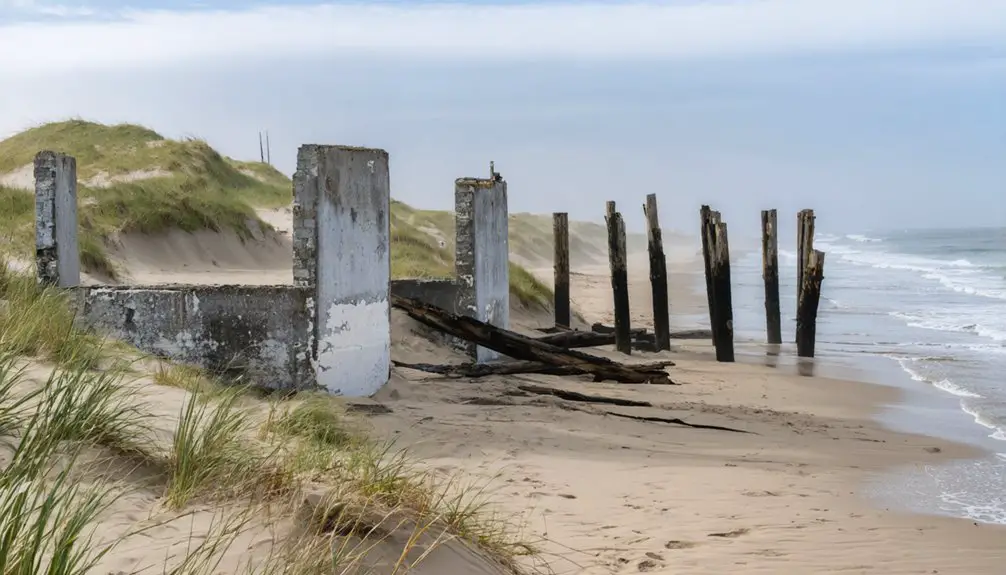
While engineering feats often protect coastal communities, flawed decisions in Bayocean’s development sealed its eventual doom.
The town’s most critical engineering failures stemmed from constructing only a single north jetty in 1932, ignoring the Army Corps’ recommendation for a paired system. This decision, combined with building on Tillamook Spit’s coastal vulnerability, proved catastrophic. Local residents contributed around $450 per household to fund the ill-fated project. Bayocean’s grand natatorium foundation crumbled as wave patterns shifted from the single jetty installation.
- The lone north jetty redirected ocean forces directly at Bayocean, accelerating erosion.
- Officials chose a $2.2 million cost-saving measure over extensive protection.
- The missing south jetty left the peninsula exposed, leading to the 1952 breach.
You can still see the consequences of these decisions today – where a thriving resort town once stood, only scattered remains hint at Bayocean’s existence before the Pacific Ocean claimed it entirely.
The Sea’s Relentless Advance
Bayocean’s engineering missteps quickly manifested in nature’s response along Tillamook Spit. You’d have witnessed the devastating progression as the North Jetty disrupted natural sand flows, starving the beaches of their replenishment.
By 1932, you would’ve seen the mighty Natatorium succumb to a powerful storm, marking the beginning of accelerated coastal destruction.
The grand Natatorium’s collapse in 1932 unleashed nature’s wrath, setting off a chain of unstoppable coastal erosion.
The sea’s assault intensified through the 1930s and ’40s, claiming 30 homes as the spit steadily narrowed. The Artisans Cooperative Community attempted to revive the town in 1934 through fishing and trade, but nature proved unrelenting.
Any hopes of coastal management crumbled in November 1952 when storms breached the isthmus, transforming the peninsula into an island. Flooding tides ravaged Tillamook Bay’s oyster beds and levees, while altered currents crippled navigation channels.
Though environmental restoration efforts began with the 1956 breakwater, they couldn’t reverse the damage already done.
A Community’s Final Days
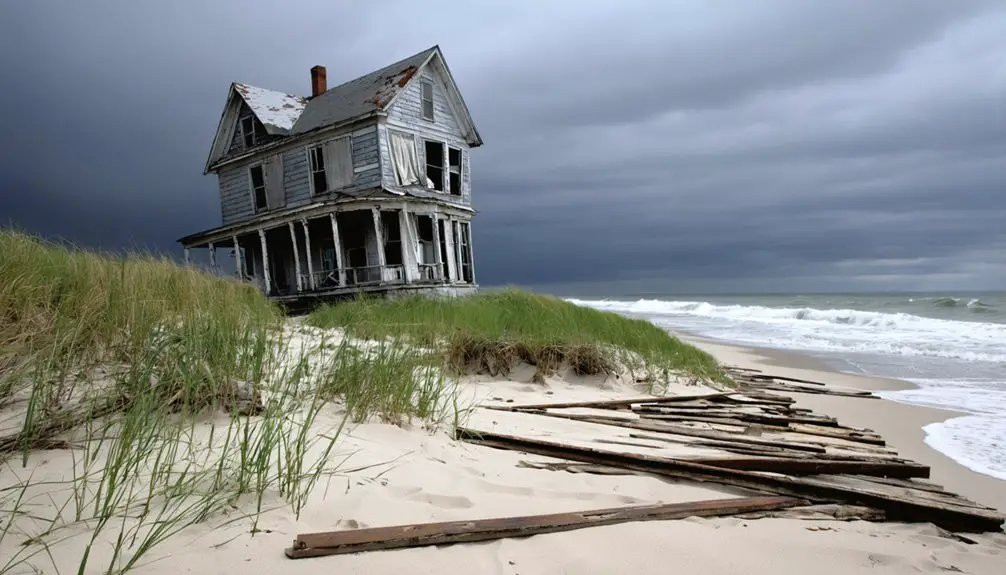
Once a bustling resort community of 2,000 residents in 1914, Bayocean’s final chapter unfolded through a rapid succession of closures and abandonments.
You’d have witnessed the town’s social hierarchy crumble as high-status homes emptied and butler-served households vanished. The community nostalgia lived on through stories of dance halls, movie nights, and swimming at the natatorium, even as nature reclaimed the streets.
Watch as Bayocean’s final days played out:
- Infrastructure failed as maintenance ceased, leaving rusting vehicles and appliances scattered across the landscape.
- Residents salvaged what they could, floating homes up the Tillamook River or hauling them by truck.
- The post office’s closure in the 1950s marked the formal end of town status, just before the last house fell to the sea in 1960.
Environmental Impact on Tillamook Bay
The 1952 breach of Bayocean spit drastically altered Tillamook Bay’s ecosystem, flooding the bay with ocean water that changed its delicate salinity balance.
You’d have seen the devastating impact on the local oyster industry as massive sand deposits smothered the beds, destroying an essential economic resource.
The breach’s effects rippled through the bay’s ecosystem, with saltwater intrusion damaging nearby dairy farmlands and reshaping the area’s agricultural potential.
Oyster Industry Collapse
When a severe storm breached Bayocean Spit’s narrow isthmus in 1952, it triggered devastating consequences for Tillamook Bay’s thriving oyster industry.
You’d have witnessed massive amounts of sand pouring into the bay, smothering essential oyster habitat and destroying the area’s natural levees. This environmental catastrophe led to a rapid industry decline, hitting harder than decades of previous overharvesting.
- Sand influx buried productive oyster beds, severely reducing populations
- Changed water flow patterns disrupted oyster larval settlement areas
- Four years passed before breakwater construction finally stabilized conditions
The breach’s impact went far beyond the immediate sand damage.
What you’re seeing today in Tillamook Bay reflects this historic collapse – though restoration efforts through the Tillamook Estuary Partnership now aim to recover these once-productive oyster grounds.
Bay Salinity Changes
Beyond the oyster industry’s collapse, shifting salinity patterns fundamentally altered Tillamook Bay’s ecosystem throughout the mid-20th century.
You’d have noticed dramatic changes in the bay’s two-layer system, where freshwater and saltwater dynamics fluctuated seasonally. The bay’s salinity fluctuations intensified as extensive logging and splash damming disrupted natural watershed processes, leading to increased sediment loads and altered river flows.
During winter months, you’ll find the bay receiving peak freshwater discharge of 8,400 cubic feet per second, while summer flows drop to just 400 cfs.
These ecosystem impacts have been further complicated by climate variability, with the Pacific Decadal Oscillation influencing precipitation patterns and river discharge.
Today, you’re witnessing a bay that continues to adapt to these changes, with varying salinity levels affecting everything from fish habitats to shellfish survival.
The Last Building Falls
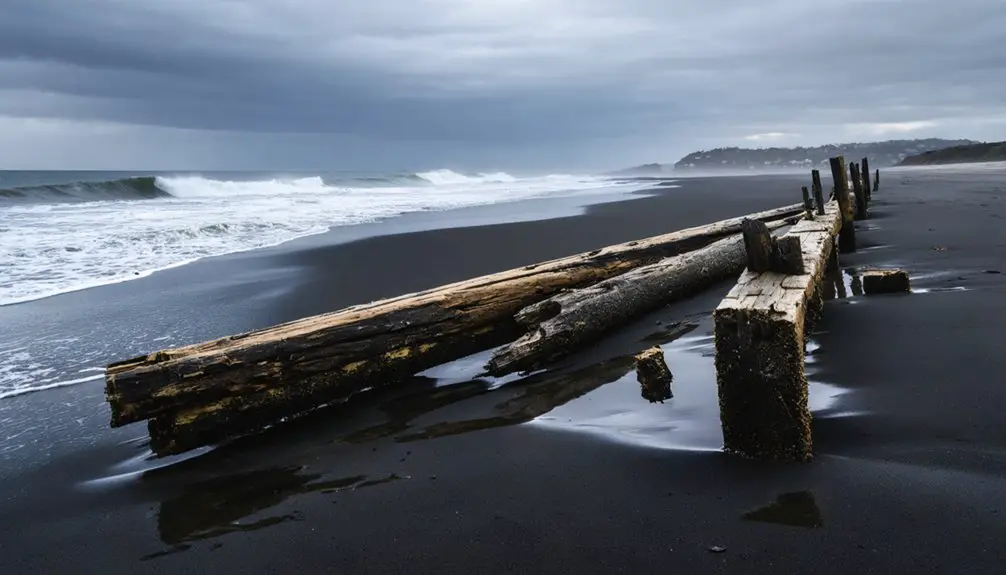
Following decades of decline, Bayocean’s final physical remnant disappeared in 1971 as its last standing structure, a solitary garage, succumbed to the relentless Pacific Ocean.
The structural collapse marked the end of a drawn-out battle against erosion that had already claimed the town’s iconic buildings, including the natatorium in 1932 and the last house in 1960.
- You can trace Bayocean’s demise to the flawed single jetty construction that disrupted natural sand movement.
- You’ll find evidence of desperate preservation efforts, as some residents moved their homes inland by cutting them in half.
- You’re witnessing the result of nature’s power, as winter storms between 1939-1952 systematically destroyed the town’s foundation.
The transformation from thriving resort to ghost town was complete, leaving only memories beneath the waves.
Lessons From a Lost Resort
Bayocean’s dramatic transformation from luxurious resort to submerged ruins offers vital lessons for modern coastal development.
You can’t simply build your dreams on shifting sands without understanding nature’s forces. The developers’ bold vision of creating the “Atlantic City of the West” collapsed because they ignored essential coastal sustainability principles and erosion risks.
Their decision to construct only a north jetty accelerated the spit’s destruction, proving that partial solutions can be worse than none at all.
Half-measures in coastal engineering can trigger devastating chain reactions, turning planned solutions into accelerants of destruction.
If you’re considering coastal development today, remember Bayocean’s fate. Success requires thorough environmental analysis, respect for natural sediment flows, and integrated coastal management strategies.
What seemed like minor oversights in 1906 – building on unstable dunes and altering coastal dynamics – led to the complete disappearance of a once-thriving resort town.
Visiting the Ghost Town Today
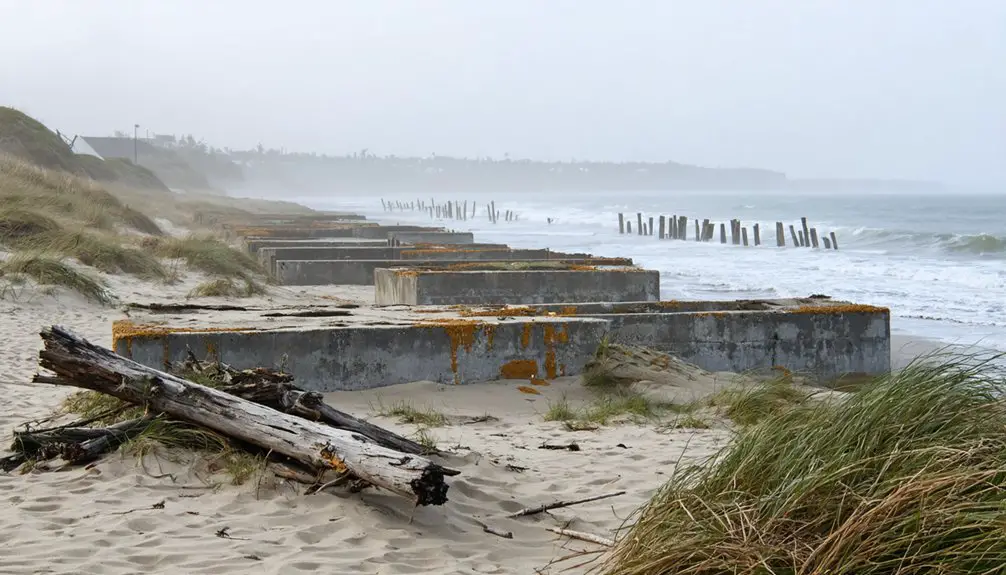
Today, curious visitors can explore what remains of Bayocean at the Bayocean Peninsula County Park, situated on a windswept sandspit between Tillamook Bay and the Pacific Ocean.
You’ll find interpretive signs along the 7.5-mile Bayocean Spit Loop Trail telling the story of this vanished resort town, while coastal erosion has reclaimed all physical traces of the once-thriving community.
For the ultimate ghost town experience, you can:
- Hike the loop trail for panoramic views of both Tillamook Bay and the Pacific Ocean
- Observe diverse wildlife and birds in their natural habitat
- Photograph the rugged coastline and dunes where buildings once stood
The park’s natural beauty now reigns where the “Atlantic City of the West” once flourished, offering a powerful reminder of nature’s dominance over human ambition.
Frequently Asked Questions
What Happened to the Residents After They Were Forced to Leave?
You’ll find most residents dispersed throughout Tillamook, facing relocation challenges as they moved inland. Some lucky ones transported their homes, while others preserved community memories through photographs and stories they’d share.
Were There Any Deaths Associated With the Town’s Destruction?
While ghostly legends and local folklore surround Bayocean’s demise, you won’t find any documented deaths linked to the town’s destruction – residents had time to evacuate as erosion slowly claimed their homes.
How Much Would a Typical Lot or House Cost in Bayocean?
You can’t accurately determine historic property values since specific real estate prices weren’t documented, though lots sold at premium rates during 1907-1914. Today, the land’s submerged state makes valuation impossible.
Did Any Original Artifacts or Memorabilia Survive From Bayocean?
Like scattered treasures in time’s vault, you’ll find surviving Bayocean artifacts and historical memorabilia in museums, including photographs, brochures, calendars, and newspaper clippings preserved by the Oregon Historical Society.
Were There Any Attempts to Save or Relocate Buildings Before Destruction?
You’ll find limited preservation efforts occurred in the 1950s, when some houses were cut apart and floated up Tillamook River. However, there weren’t organized relocation plans during early erosion years.
References
- https://en.wikipedia.org/wiki/Bayocean
- https://www.orrfa.com/posts/ghost-towns-of-the-oregon-coast-bayocean-a-lost-resort-town
- https://www.oregonencyclopedia.org/articles/bayocean/
- https://thatoregonlife.com/2017/01/bayocean-ghost-town/
- https://www.youtube.com/watch?v=dl4MeF5pTOw
- https://offbeatoregon.com/1611b.bayocean-town-swallowed-by-the-sea-417.html
- https://www.opb.org/news/article/oregon-bayocean-ghost-town-resort-tillamook-bay/
- https://www.oregonencyclopedia.org/articles/bayocean/pdf/
- https://oregoncoastalliance.org/bayocean-spit-targeted-for-resort-development-again/
- https://www.bayocean.net/p/the-bayocean-story-in-brief.html
